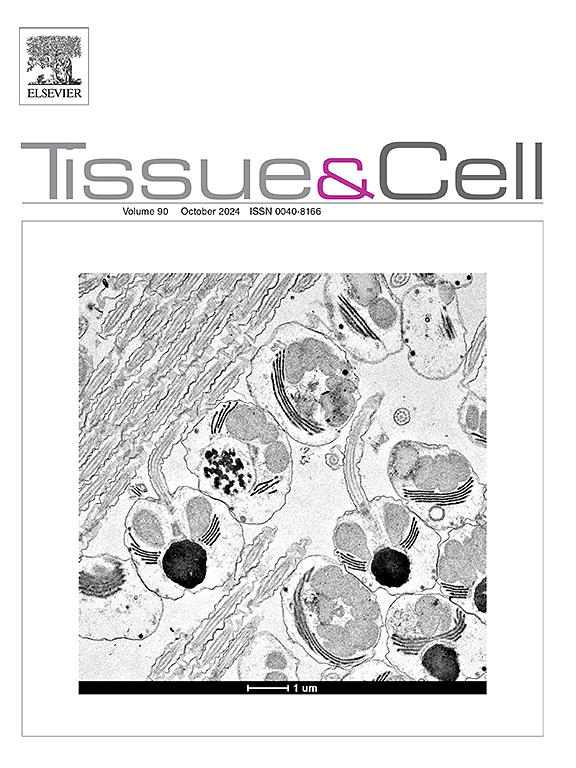Soluble α-Klotho protects dermal microvascular endothelial cells against endothelial-to-mesenchymal transition
IF 2.7
4区 生物学
Q1 ANATOMY & MORPHOLOGY
引用次数: 0
Abstract
Endothelial-to-mesenchymal transition (EndMT) is a key contributor to dermal fibrosis. The soluble form of the α-Klotho (sKL) hormone has been shown to counteract fibrotic processes in multiple organs, but its role in dermal fibrosis and EndMT remains unexplored. To investigate whether sKL may inhibit transforming growth factor β1 (TGFβ1)-induced EndMT in human dermal microvascular endothelial cells (H-dMVECs), cells pretreated with recombinant human sKL and subsequently stimulated with recombinant human TGFβ1 were assessed for morphological changes, gene and protein expression of both endothelial and mesenchymal/myofibroblast markers, and functional contractility through qPCR, Western blotting, immunofluorescence, and collagen gel contraction assays, respectively. TGFβ1-treated H-dMVECs underwent significant changes in cell morphology, with loss of endothelial markers (i.e., CD31 and VE-cadherin) and a concomitant increase in the expression of mesenchymal/myofibroblast markers (i.e., α-smooth muscle actin, type I collagen, and S100A4/fibroblast-specific protein 1) and of EndMT-associated transcription factors (Snail1, Twist1, and Zeb1). Moreover, TGFβ1-treated H-dMVECs acquired the ability to contract collagen gel matrices. Pretreatment with sKL significantly attenuated all the aforementioned morphological, molecular, and functional changes, preserving the endothelial phenotype and mitigating myofibroblast-like contractile activity. In conclusion, sKL effectively prevented TGFβ1-induced EndMT in H-dMVECs, highlighting its potential as a novel therapeutic agent against dermal fibrosis.
可溶性α-Klotho保护真皮微血管内皮细胞免受内皮向间质转化
内皮-间充质转化(EndMT)是真皮纤维化的关键因素。α-Klotho (sKL)激素的可溶性形式已被证明在多个器官中抵消纤维化过程,但其在真皮纤维化和EndMT中的作用仍未被探索。为了研究sKL是否可以抑制转化生长因子β1 (tgf - β1)诱导的人真皮微血管内皮细胞(H-dMVECs)的EndMT,我们通过qPCR、Western blotting、免疫荧光和胶原凝胶收缩实验,对经重组人sKL预处理并随后经重组人tgf - β1刺激的细胞进行形态学改变、内皮和间充质/肌成纤维细胞标志物的基因和蛋白表达以及功能收缩性的评估。分别。tgf - β1处理的H-dMVECs细胞形态发生了显著变化,内皮标记物(即CD31和VE-cadherin)缺失,同时间充质/肌成纤维细胞标记物(即α-平滑肌肌动蛋白、I型胶原和S100A4/成纤维细胞特异性蛋白1)和endmt相关转录因子(Snail1、Twist1和Zeb1)的表达增加。此外,tgf β1处理的H-dMVECs获得了收缩胶原凝胶基质的能力。sKL预处理可显著减弱上述形态学、分子和功能变化,保留内皮表型并减轻肌成纤维细胞样收缩活性。总之,sKL有效地阻止了tgf β1诱导的H-dMVECs的EndMT,突出了其作为一种新的真皮纤维化治疗剂的潜力。
本文章由计算机程序翻译,如有差异,请以英文原文为准。
求助全文
约1分钟内获得全文
求助全文
来源期刊

Tissue & cell
医学-解剖学与形态学
CiteScore
3.90
自引率
0.00%
发文量
234
期刊介绍:
Tissue and Cell is devoted to original research on the organization of cells, subcellular and extracellular components at all levels, including the grouping and interrelations of cells in tissues and organs. The journal encourages submission of ultrastructural studies that provide novel insights into structure, function and physiology of cells and tissues, in health and disease. Bioengineering and stem cells studies focused on the description of morphological and/or histological data are also welcomed.
Studies investigating the effect of compounds and/or substances on structure of cells and tissues are generally outside the scope of this journal. For consideration, studies should contain a clear rationale on the use of (a) given substance(s), have a compelling morphological and structural focus and present novel incremental findings from previous literature.
 求助内容:
求助内容: 应助结果提醒方式:
应助结果提醒方式:


